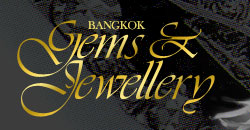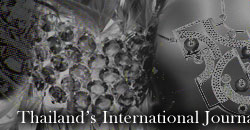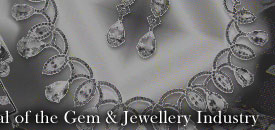| |
| |
The
GIA has announced that it will issue standard heat treatment certificates
for the Sri Lanka Blue Sapphire with unusual colour concentrations.
The controversy over the gem's treatment process began in early
2003 when the unusual color concentrations were brought to the trade's
attention byu the GIA and AGTA .By mid 2003 ,the AGTA had already
cleared the stone but the GIA continued their deliberations as they
conducted extensive research into the gems' colour concentrations
and heating process. |
|
|
|
Figure
1 : In the past several months,The GIA Gem Laboratory has
examined dozen of blue sapphires that showed clear evidence of high-temperature
heat treament as well as unusual colour concentrations.The stone
have ranged from1 to about 20carats. The face-up appearance of these
two 3 carats.sample is representative of the material. |
|
|
|
|
|
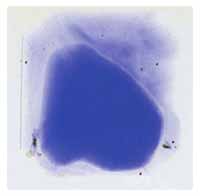 |
Figure
2 : Inimmersion,these heated blue
sapphire reveal unusual ,billowy colour concentrations,a narrow
near-colorless boundary follows the contours of the inner blue colour
concentrations. |
|
|
|
|
|
|
|
|
|
|
|
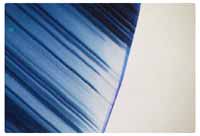 |
Figure
3 : Commonly these unusual colour
concentrations also display a scalloped edge at the boundry with
the colorless region. Note, however, that the parallel growth planes
extend across both the inner and outer colour becomes abruptly lighter
or less saturated. |
|
|
|
|
|
|
|
|
|
|
|
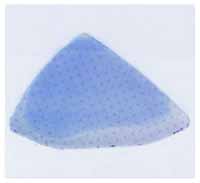 |
Figure
4 : One hundred and eighty -seven
spot analyses were taken by LA-ICP-MS to map the full chemical composition
of thsi sample.No syntematic chemical variation was recorded between
the inner blue color concentration and the outer decolorised region.
|
|
|
In April 2004 ,the
Institute finally gave the gems a clean chit.in a statement is a GIA
siad that "As a result of this extensive research,GIA has conclude
that the color phenomenon observed in these stone is a product of
a specific heating regimen used by Mr. Punsiri Tenakoon of Poonsiri
Gems ,Ratanapura,SriLanka . We have found no evidence of international
or inadvertent diffusion of element from an outside source that would
require special disclosur on our gemstone reports. Therefore, blue
sapphire that have indication of heat treatment,as well as characteristics
and properties similar to the stones examined during this research
project , will be disclosed with the standard heat-treated comment". |
|
|
|
|
|
|
|
|
 |
|
|

|
|
|
|
|
1.Marchak 2.CR Bruner 3.Waddy Jewelllery
4. Martin Flyer |
|
|
|
|
|
Design Trends exhibited at BaselWorld
point to the exuberance and optimism felt by the trade and the consumers
as big sized jewels in bold design and every possible hue and shade
were on display .Small pieces are dated is the message that came across
lound and clear.There is a brillaint and joyously abadoned exuberance
in all the dangly briolettes in candy colour that were troughout the
booths at the show.Coloured diamond are hot and big exclusive diamond
is all the rage .Small discreet pieces as advocated by Miss Manners,are
definitely out.If you are got it - flaunt it
is the designer mantra of the day. Semi precious is getting to be
hotter than precious becuase it can give size ,lustre and gulity without
breaking the bank and is increasingly being seen in high end jewelery
as well. |
|
|
|
|
|
|
|
|
 |
|
|
1.David Yurman 2.Magerit Joyas 3. H Sten
4.Magerit Joyas 5.Kan Ngai Jewellery 6.Bapalal Keshavlal 7. Manoel
Bernardes |
|
|
|
|
|
|
|
|
1.Jade by Nikolai 2.Carera y Carera 3.CR
Bruner 4. Rosy Blue's Tamarine diamond necklace |
|
|
|
|
|
 |
|
|
1.Benchmark 2. H. Grigoire 3. Friedrich
Stahl Design 4. Guy Laroche 5. Aurafin |
|
|
|
|
|
 |
|
|
1.Vianna 2. Vancox 3. Bracelet Inc.Jack
baguette Co. 4.Denis Hazell Int'l ltd 5. Breuning,Lawrenceville,GA |
|
|
|
|
|
|
|
|
 |
|
|
Jade,
which is called the Stone of Heaven by the Chinese, is actually two
different gem materails altogather,a fact which remained undiscovered
until the end of the nineteenth century.In this pieces on Jade ,we
will focus primarily on the differences between the two varieties
of Jade |
|
|
|
|
|
|
Jade
is a name that was erroneously given to two separate and distinct
gem materials-jadeite and nephrite - many centuries ago.it was only
in 1863 that this anomaly was uncovered by scienctist.Historically
though , Jade has been used by many cultures and societies such
as the Chinese ,the Maya,Aztecs,Incas,Olmecs,Maoris,Turks,as well
as many Neolithic peoples. It was brought to Europe by the Conquistadors
who invaded South Africa .Its current names jadeite and nephrite
as well as the term jade also came from the Europeans.
Historical Applications
The Chinese and the South Americans
,though on oposite sides of the globe ,both accorded jade the utmost
respect and valued it more than gold too. In fact , so revered
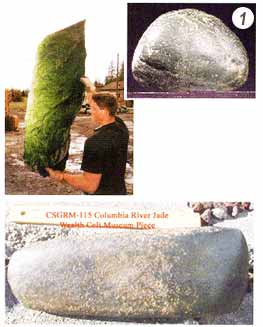
1. Boulders of jade are sold with a small window
cut to only give an indication of what is inside.For most dealers,buying
is therefore largely a gamble
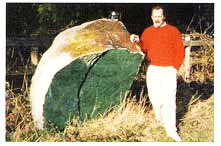
was jade by the Chinese
that they called it the Stone of Heaven.They even drank a mixture
consisting of powered jade in the belief that it confered longvity.
The Europeans associated it with the curing of kidney ailments and
nepphrite actually gets its name from the Greek word for kidneys.Jade
itself is a European name ( the Chinese called is YU). The Spaniards
called it Piedra de Hijada ( meaning the stone of lion ) and in
corruption
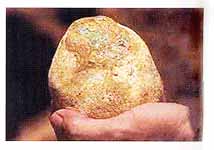
of this term .the French
called it jade and from that came the name jade. The South and Central
Americans used it for ceremonial purposes and it was often buried
in the tombs of thier kings. The chinese too ,followed this practice.In
Japan, the use of Jade dates back 4000 years and was mostly associated
with tool used by shamams.
Interestingly enough ,jade was once used as a tool by the Neolithic
people also , namely tools of the hard labour variety like axes
,knives,scrapers and weapons,etc.With the coming of the Bronze Age,
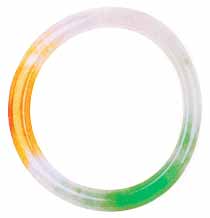
Bangles such as at this one are among
the hottest selling jade items in the Far East.
|
|

jade's utilitarain importance diminished but its
symbolic value never dimmed .Even today, modern man,especially
in the Far East , uses jade amulets as good luck charm and jade
doughnuts are probably the most popular cut for this stone.
The Discovery
The discovery that jade was acctually
two separate minerals belonging to two separate families with
two separate sets of physical characteristics was made in the
late
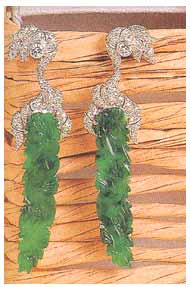
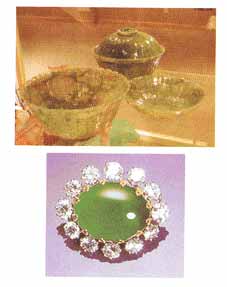
1800's when the science of geology
had made significant progress. At the time ,all opaque green stones
were loosely classified as jade until the development of crystallography.
At that time mineralogist began classifying gemstones based on
the mineral they were composed from and how those minerals crystallized
.In the process they discovered that despite a fairly similar
appearance ,the two kinds of jade-jadeite and nephrite -accually
belonged to two different mineral families Nephrite already existed
as the name for the old type of jade and the other kind was termed
jadeite by the scientists.
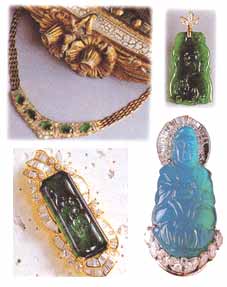
So what is thedifference?
Well, to start with ,although both
jadeite and nephrite are based on silica ,the secondary mineral
in nephrite is magnesium and in jadeite is aluminium. Also nephrite
gets its green colour from trace amountsof iron, while jadeite's
verdure is due to chromium ,
|
|
the same element that colour emeralds,It must
be pointed out though,that likediamonds,both varieties of jade
in thier pure from are white .However ,unlike fine diamond ,jade
is at best semi translucent while more commonly it is opaque .
Impurities yield other colours.In nephrite these include beige,yellow,blue
or black among other colours, while in jadeite, the range is blue
-green,lavender,white,orange and red .Compare to nephrite ,jadeite's
hues are more beatiful,the colours more vivid and this is especially
true of the greens.it is mainly due to this that jewelers value
jadeite more than nephrite,but of course,there nephrite,but of
course,there are other more compelling reasons as well.
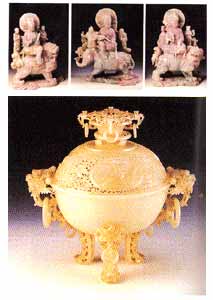
One of the chief differences
between nephrite and jadeite is the occurence. As with all other
gemstones,rarity is one of the main factors that govern value.Nephrite
and abadantly found in literally thousands of occurances and therefore
nearly every ancient facts ,until the1800's , the isolationist
Chinese use only nephrite as jadiite occured outside their boundaries
(in Burma). Jadeite on the other hand occurs only in seven locations
throughout the world .These are Myanmar (Burma),California ,Guatemala,Russia
(near Lake Baikal ),japan and Switzerland. Apart from colours,there
are other differences in appearance.Nephrite 's crystal pattern
can be seen with the naked eye. it consist of long slender crystal
stacked together to from a mat likt sheet.Jadeite's crystal pattern
on the other hand ,can barely be seen as it is microcrystalline
.Nephrite feels soapy or oily to the touch ,while jadeite feels
pearly or satiny .Also ,jadeite always feels feels warm to the
touch while nephrite feels cool.
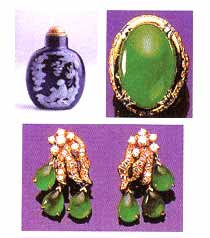
Nephrite gives a hollow
ring when bounce together, while the same action will produce
a sound akin to the clashing of billiard balls from jadeite.Also,jadite
gives the impression of depth when viewed , unlike nephrite .Their
mineral families are different too, nephrite belongs to the amphilbole
group and jadeite is part of the pyroxene group of minerals. Speaking
of minerals and mineral structure, there are two physical characticteristics,which
distinguish the two minerals from each other.Jadeite is harder
than nephrite and will scratch it while nephrite is together than
jadeite and therefore will not shatter as easily as the letter.The
surface fracture of jadeite is granular, while that of nephrite
is splintery.The specific gravity of the two stones is different
too with jadeite being the heavier with a specific gravity of
3.24-3.40 while nephrite is a relatively lighter 2.90-3.10 The
ultimate difference though is decided by the two-
|
|
|
|
|
|
|
|
|
|
|
|
|
|
|
|
|
|
|
|
|
|
|
|
|
|
materails and the market
remains the final arbitrator as to which one is the more important
of the two.While nephrite can be had for just a few dollars,Jadeite
can command prices that to go up to thousands of dollars per carat
. In the international market, jadeite is commomtly sold by the
ounce and nephrite by the pound or kilogram,and in that is encapsuled
the sum of all the differences.
So which one is the real jade?
Historically speaking,it is obviously the
more abudant nephrite that could be easily mined,which was mailny
used as jade but in 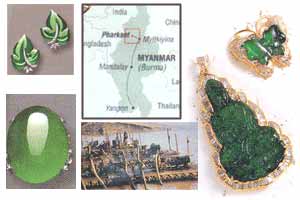 modern
times,the gem quality and precious materail is definitely jadeite
and thus both minerals retain their claim to the name jade. modern
times,the gem quality and precious materail is definitely jadeite
and thus both minerals retain their claim to the name jade.
How does one test the differences?
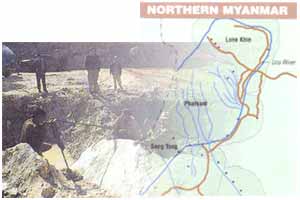 The
scratch test is a destructive way in which to tell the difference.As
jadeite is harder than nephrite it will scratch it.Again,the difference
in specific gravity can be tested by immersing the two stones in
methylene iodide,nephrite will float and jadeite will sink.A refractive
index test will also point out the difference.Another destructive
test to distinguish between the The
scratch test is a destructive way in which to tell the difference.As
jadeite is harder than nephrite it will scratch it.Again,the difference
in specific gravity can be tested by immersing the two stones in
methylene iodide,nephrite will float and jadeite will sink.A refractive
index test will also point out the difference.Another destructive
test to distinguish between the
two to subject them to heat with a propane or butane torch(thin
silver cut out of
the materails to be tested ) .Jadeite will
fuse to the point of a small biol or even
melt . X ray diffraction is a precise method but can only be undertaken
in
laboratories .
The trader who buy jadeite do not
get the benifits or really knowing what they are buying.They get
to see no more than a small
 window
cut into the boulder of jadeite to show a glimps of the stone's
interprior.The buyers have no way of knowing window
cut into the boulder of jadeite to show a glimps of the stone's
interprior.The buyers have no way of knowing
wether the stone will be valueabe green jadeite or inexpensive brown
stained materail.The buyers have only their
instince to guide them and based on that, they literally gamble
hundreds of thousands of dollars on somthing that
might either be worth a king's ransom or complete worthless.
The current center of the trade in jade
Every year the Mynmar Gems Enterprise
( owned by the government of Myanmar ) holds the Myanmar 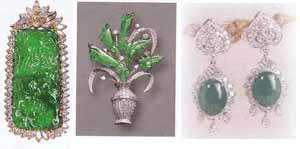 Gems,Jade
and Pearl Emporium where boulders of jadeite are sold by tender
to the top jade dealers around the world and this is one of the
most improtant event in the jade industry.Auctions of jade jewellery
usually net top dollar in Hong Kong and the finest collection of
jade artifacts is possibly in the Taipei Meseum and thus, while
jade might have had a more global following in centuries past, in
modern times,we can say that it is an industry that basically thrives
in the Far East. Gems,Jade
and Pearl Emporium where boulders of jadeite are sold by tender
to the top jade dealers around the world and this is one of the
most improtant event in the jade industry.Auctions of jade jewellery
usually net top dollar in Hong Kong and the finest collection of
jade artifacts is possibly in the Taipei Meseum and thus, while
jade might have had a more global following in centuries past, in
modern times,we can say that it is an industry that basically thrives
in the Far East.

|
|
|
|
|
|
|
|
|
|
|
|
|
